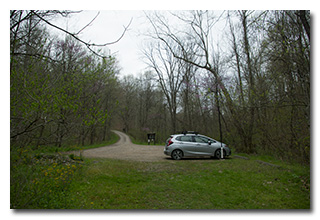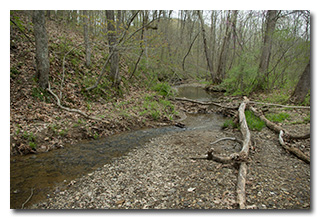
by William Eric McFadden
From the nature preserve's website:
-
This 491-acre preserve encompasses a variety of habitats typical of Appalachian Ohio. The area is diverse in vegetation and ranges from various successional stages to mature forests in the deep ravines and on the steep hillsides. The area is dissected by Jordan Run, a tributary of the Hocking River, and has steep topography, varying from 680 to 900 feet in elevation. Large beech and oak trees are found in the cool moist ravines while the drier uplands are dominated by oak hickory forests, typical of the region.
Due to the diversity of the landscape, a large variety of ferns and wildflowers abound. Some of the more interesting plants include weak aster, green adder's-mouth orchid and Virginia meadow-beauty. Mistletoe, a parasitic plant on trees, has also been reported from this preserve. The most notable landscape feature is a large pond created by beaver, complete with many trees bearing the marks of these industrious animals and a stick-built den. The pond, which stretches for several acres, draws a variety of migratory waterfowl.
The preserve was a gift of Henry I. Stein, who gave the area to the Division of Natural Areas and Preserves in 1974 as a memorial to his sister, Marie J. Desonier.
Pictures
Description
 On Friday, April 29, 2022, one member of the Southeast Ohio Radio Adventure Team
performed a successful activation of Desonier State Nature Preserve in Ohio as part of the Parks on the
Air (POTA; link) program.
On Friday, April 29, 2022, one member of the Southeast Ohio Radio Adventure Team
performed a successful activation of Desonier State Nature Preserve in Ohio as part of the Parks on the
Air (POTA; link) program.
Eric McFadden, WD8RIF, visited Desonier State Nature Preserve on an overcast, 50° but warming morning, arriving at about 1325 UTC. Eric was accompanied by his small dog, Theo. This was the seventh CW POTA activation of Desonier State Nature Preserve, with all the previous CW activations having also been performed by Eric.
Upon arrival at the unoccupied parking lot, Eric parked, walked Theo, and quickly deployed his 28½' wire vertical on a Jackite 31' telescoping fiberglass mast and drive-on mount. Because of the cool temperature, Eric mounted his KX3 inside the car and was on the air at 1336 UTC.
As he had expected, Eric found he had good cell-signal at this location, and he was able to spot himself to POTA Spots (link) and to use POTA Spots to identify possible park-to-park (P2P) QSO opportunities.
 Eric had been concerned about poor conditions on the HF bands but, upon checking 40m, was pleased to hear a low noise
floor. Eric found a frequency to run on 40m, began calling CQ, and spotted himself to POTA Spots. Eric's first QSO
came at 1339 UTC, after three minutes of calling CQ, and was a P2P QSO with NK8O, a Kansas-based operator who was
performing a POTA activation of Lake Guntersville State Park (K-1044) in Alabama. QSOs came steadily, with Eric's
eighth QSO coming at 1348 UTC with N9VFR in Illinois. This run included the aforementioned P2P QSO and QSOs
with operators located in Alabama (2), North Carolina, Wisconsin, Pennsylvania (2), Massachusetts, and Illinois.
Eric had been concerned about poor conditions on the HF bands but, upon checking 40m, was pleased to hear a low noise
floor. Eric found a frequency to run on 40m, began calling CQ, and spotted himself to POTA Spots. Eric's first QSO
came at 1339 UTC, after three minutes of calling CQ, and was a P2P QSO with NK8O, a Kansas-based operator who was
performing a POTA activation of Lake Guntersville State Park (K-1044) in Alabama. QSOs came steadily, with Eric's
eighth QSO coming at 1348 UTC with N9VFR in Illinois. This run included the aforementioned P2P QSO and QSOs
with operators located in Alabama (2), North Carolina, Wisconsin, Pennsylvania (2), Massachusetts, and Illinois.
Pausing to check POTA Spots for P2P QSO opportunities, at 1348 UTC Eric made a P2P QSO on 40m with K4QD who was activating Taylor Creek State Conservation Area (K-8721) in Florida. Unfortunately, poor band conditions and fading prevented Eric from completing a P2P QSO on 40m with his buddy K4SWL who was activating New River State Park (K-2748) in North Carolina.
Returning to 40m to run a frequency, Eric's first QSO in this run came at 1354 UTC with KA1DMA in Connecticut. QSOs again came steadily, with Eric's fifth QSO in this run coming at 1404 UTC with NX1K in Massachusetts. This run included QSOs with operators located in Connecticut, Minnesota, Massachusetts (2), and Georgia.
In all, Eric made fourteen QSOs, including two P2P QSOs, in about half an hour. All of Eric's QSOs were CW and were made with five watts output.
Under normal propagation conditions, Eric would have expected QSOs to have come more quickly. Still, those stations Eric worked were, almost with exception, strong and the signal reports he received similarly didn't indicate poor propagation. This gave Eric hope that his upcoming activation of Muskingum River State Park would be similarly successful.
(return)